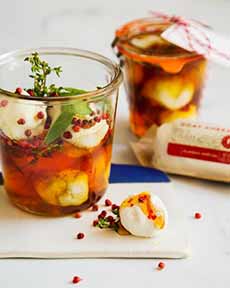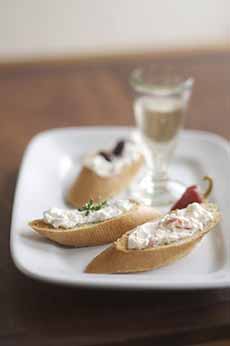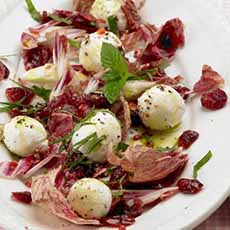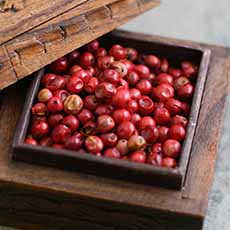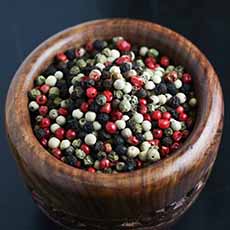RECIPE: Homemade Valentine Gift ~ Goat Cheese Bites
|
Here’s a delicious bite with a Valentine’s Day accent—although it’s a yummy bite any day of the year (photos #1 and #2). Whether for your own home or as a homemade gift, a cheese lover may be more appreciative of this gift than with empty-carb chocolate or homemade cupcakes. The recipe takes immerses cheese balls in honey, olive oil and pink peppercorns. There’s more about them below. It’s the pink peppercorns (photo #5) and the honey sweetness that add the Valentine touch. > The different types of cheese: a photo glossary. > The history of goats and goat cheese. The honeyed goat cheese balls are perfect on: By the way, fried goat cheese balls are a popular appetizer and party snack. You can find quite a few recipes online. You’ll need a nice jar or other refrigerator container for gifting. Prep time is 10 minutes; marinating time is 1 hour or longer. The goat cheese balls can be stored up to 7 days in the fridge. Remove 1 hour prior to serving. Preparation 1. REMOVE the cheese from the packaging and cut it into 8 slices. 2. ROLL each slice into a ball and place in a clean jar. 3. ADD the herbs and pink peppercorns. 4. FILL jar with honey, and put the lid on. 5. LET the flavors blend for at least one hour. The flavors will deepen as the goat cheese sits in the honey. Pink peppercorns, also called rose pepper or red peppercorns, are often found for sale in mixes with black, white and green peppercorns (photo #6). This may lead one to think that they’re a form of Piper nigrum* like the other three varieties—but they’re no relative of any kind. Pink peppercorns are berries from the Baies rose plant (Schinus molle, family Anacardiaceae), a small mastic tree† related to the rose bush. It is found on the French Island of Reunion in the Indian Ocean. The berries have a beautiful rose color and a delicate, fruity, slightly tart/citrus zest flavor with a mild pepperiness: a delicate bouquet and a sweet and spicy flavor with undertones of citrus zest. Pink peppercorns became popular with the rise of nouvelle cuisine in the 1980s. They tend to be expensive, but you don’t need much to make an impression. Schinus molle is often confused with Schinus terebinthifolius, the Brazilian Pepper Tree, also called the Peruvian pepper plant and even the California pepper tree. It produces a very similar-looking berry that is red, rather than rose, in color. Pink peppercorns go well in fruit sauces, vinaigrettes and desserts (sorbet and ice cream, puddings, baked goods). They are wonderful in vegetable, chicken and seafood dishes, especially in cream sauces. From a visual perspective, a sprinkling of pink peppercorns makes any dish look more beautiful. Paul “Sweet Paul” Lowe is the creative guru behind the quarterly Sweet Paul Magazine. His creations are simple, elegant meals and stylishly easy crafts. Anyone seeking homemade and handmade should check out Sweet Paul Magazine, guaranteed to enhance everyday life. |
|
|
|
________________ *Piper nigrum is the botanical genus and species of the common black peppercorn, from the family Piperaceae. Black, green, red and white peppercorns are the fruit of the same Piper nigrum vine. Green peppercorns are not yet ripe; white peppercorns are the ripe black peppercorns with the black skin removed. †A mastic tree is a particular genus of evergreen shrub or small tree. CHECK OUT WHAT’S HAPPENING ON OUR HOME PAGE, THENIBBLE.COM.
|
||

